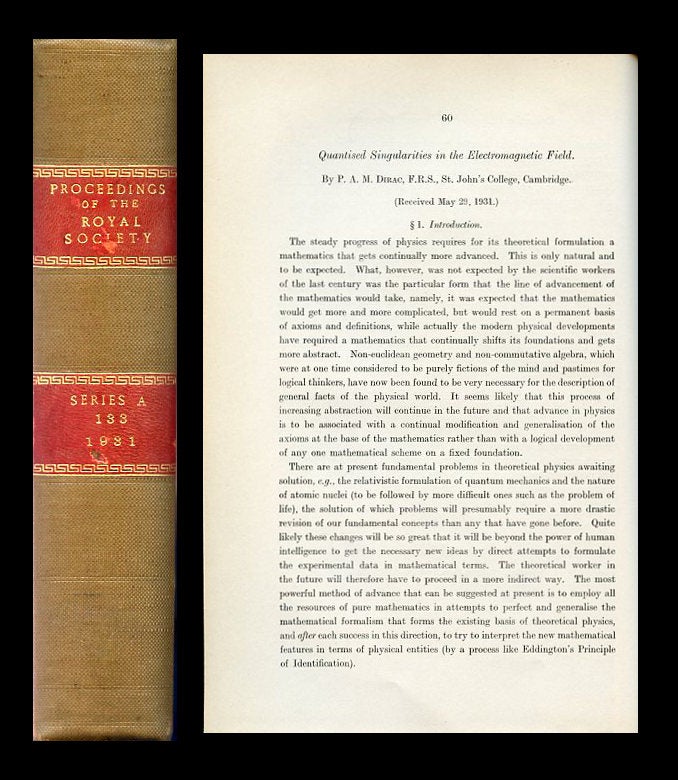Quantised Singularities in the Electromagnetic Field, in Proceedings of the Royal Society A. 133, 1931, pp. 60-72
London: Royal Society, 1931. 1st Edition. FIRST EDITION OF DIRAC’S PREDICTION OF A NEW ELEMENTARY PARTICLE – THE POSITRON – ALONG WITH MAGNETIC MONOPOLES. Though not taken terribly seriously at the time, in 1973 “Heisenberg generously called it…perhaps the biggest jump of all big jumps in physics of our century” (Kragh, Quantum Generations, 191).
In 1928, Paul Dirac formulated the so-called “Dirac equation” which describes the behavior of fermions and “was the first theory to account fully for special relativity in the context of quantum mechanics” (Wikipedia). Dirac’s new theory, however, did have a problem: the Dirac equation “formally included solutions with negative energy. Contrary to the situation in classical physics, these could not be dismissed as nonphysical but had to be taken seriously – that is, somehow to be related to some objects of nature. In 1929, Dirac believed he had found the solution to the problem… of electrons having negative kinetic energy” (ibid 190). Dirac wrote to Bohr, arguing that “not all states of negative energy are occupied, but that there are a few vacancies of ‘holes.’… [O]ne can easily see that such a hole would move in an electromagnetic field as though it had a +ve charge. These holes I believe to be protons” (Kragh 1990, 91).
“Dirac’s proton-as-electron theory, published in 1930, assumed a world of negative-energy states occupied by an infinite number of electrons governed by Pauli’s exclusion principle. Only the few unoccupied states, the ‘holes,’ would appear as observable physical entities… The hypothesis was universally met with skepticism” (ibid 191). In early 1931, Dirac realized “that the hole had to have the same mass as the electron. In the new version, as it appeared in a remarkable paper [this paper]…the antielectron was introduced for the first time as a ‘new kind of particle unknown to experimental physics, having the same mass and opposite charge to an electron (Kragh 1990). Furthermore, as the proton was now a separate species of particle, Dirac argued that it would probably have its own antiparticle.
In essence, Dirac was proposing that there had to be a “particle distinct from the proton, positively charged, but having the mass of an electron” (Peacock, The Quantum Revolution, 67). In less than a year, the American physicist Carl Anderson would discover positively charged particles in cosmic ray showers just as Dirac had predicted. Anderson named the new particles ‘positrons’ “positive electrons with precisely the same mass as the electron, but positively charged” (ibid). Item #509
CONDITION & DETAILS: Complete. 4to (Quarto). 10 x 7 inches (250 x 175mm). [vi], 695, [xiv]. Two small ex-libris stamps on the title page, one just a few numbers. In text illustrations throughout. Bound in tan cloth; two gilt-lettered red morocco spine labels. Very tightly and solidly bound. Clean and bright inside and out. Very good condition.
Price: $1,100.00


